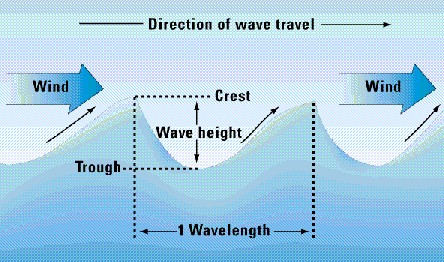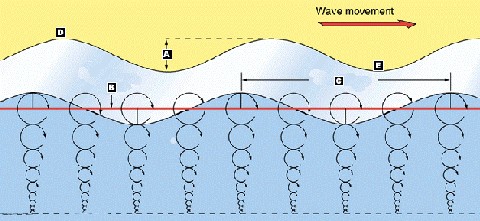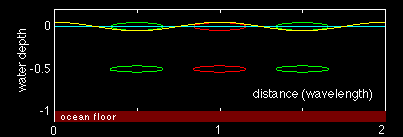Energy transmitted through matter BUT no transport of matter !
- Period (t): time that one wavelength (l) needs to pass one point [s]
- Frequency (n): number of wavelengths per unit time = 1 / t [s-1]
- Wave speed (v): distance a wave point travels per unit time [m s-1]
- Deep-water waves, z > ½ l --> v = l / t
- Shallow-water waves, z < 1/20 l --> v = 3.1 x SquareRoot(z)

- Wind deforms water surface and creates small ripples (Wavelength l < 1.7 cm; capillary waves)
- Ripples offer more troughs to catch wind, more energy is transferred into the water
- Bigger waves with l > 1.7 cm develop – gravity waves
- Wind energy increases wave height, length, speed
- Wave height increases faster than wave length, crests become pointed and troughs rounded; if wind speed = wave speed, then no net energy exchange, wave has reached maximum size and speed
- Waves break in open ocean when steepness = height/wave length = 1/7
- Factors that determine wave energy: (a) wind speed; (b) duration of wind; (c) wind fetch = distance of water over which wind blows in the same direction

- Deep water: orbital movement stops at z = ½ l, particle movement decreases exponentially with depth
-
Shallow
water: particles move on very flat ellipses.
Particle movement remains the same over the entire water depth

- Long waves move out and ahead of storm area
- Their speed is faster than wind speed outside the storm area
- Wave steepness decreases: swell
- Run over long distance with minimum energy loss
- Eventually form groups or trains of waves, which travel at ½ speed of individual waves
- Because it takes time and energy to cause the water to oscillate, the first wave disappears but new wave forms at the end of group
- Waves slow down when they come in contact with bottom
- If waves arrive at an angle different of 90°, the near-shore part ‘feels’ bottom first and slows down
- Thereby, wave fronts turn towards the coast and all waves arrive 90°
